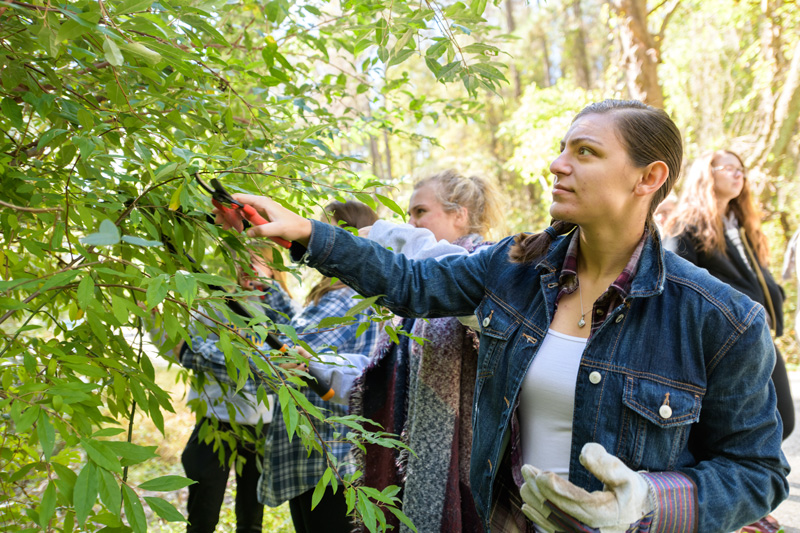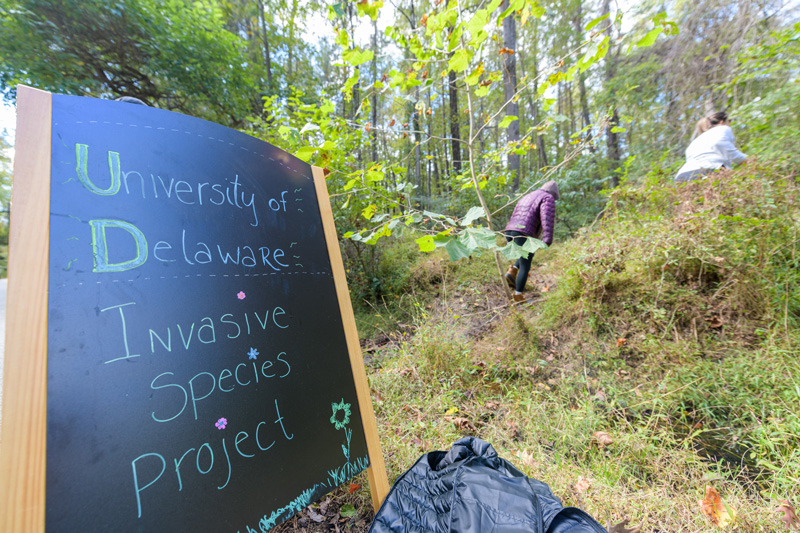


Beyond books
Photo by Evan Krape December 04, 2018
Environmental literature students tackle forest restoration
Students in the University of Delaware’s “Introduction to Environmental Literature” class regularly put aside their books and journals and head out of the classroom to a nearby state park.
There, they pick up such non-literary tools as long-handled loppers, clippers, shovels and work gloves and set to work attacking some of the many invasive plants that are damaging the forest.

As they cut, chop and dig to remove stubborn vines and dense shrubs, the undergraduates are experiencing firsthand some of the environmental problems they’ve been reading and writing about in class.
“After many years of having my students wander White Clay Creek State Park and journal about their experiences, I started something new this semester — training them to do forest restoration work,” said McKay Jenkins, the Cornelius A. Tilghman Professor of English and a founder of UD’s environmental humanities program.
In partnership with state park rangers, Jenkins and the students have learned to identify and remove some of the invasive species that can take over wooded areas, choking out native plants and damaging the biodiversity that makes for a healthy environment.
On a recent sunny fall day in the woods off Creek Road, just north of the UD campus, the class literally had its hands full with such invasives as autumn olive, multiflora rose, Japanese barberry and bittersweet.
Students struggled to remove vines that had wrapped so tightly around tree trunks that it was almost impossible to pry and then cut them loose. They worked in teams to chop away at invasive bushes that had become thoroughly entangled with native plants.
The class learned that the problem is widespread across the U.S., with non-native plants threatening the health of woodlands and depriving insects and animals of their native food sources.
“Once you know about this issue, and once you learn to identify some of the invasive species, you start to see that non-native plants are everywhere,” said Katey McCarthy, a senior majoring in communication. “Some of them are beautiful, but knowing about the problem really changes your perception of them.”
Like many of her classmates, McCarthy said she appreciated a class in which she was able to see real examples of what she had been reading about.
Sophomore English major Henry Wolgast signed up for the class because of his interest in exploring different writers’ philosophies about the natural world. The class provides that, he said, but with the added benefit of hands-on experience.
“It’s a great class and a great chance to get more familiar with environmental issues,” he said. “It’s made me want to get more involved with these kinds of efforts.”

On this day, the group was joined by Tara Trammell, the John Bartram Assistant Professor of Urban Forestry in UD’s College of Agriculture and Natural Resources. She shared some of her own research in the field with the students, describing the complexity involved in trying to eradicate the wide variety and large number of invasive plants in any particular area.
“There can be so much variability in a species, even on the same tree, that you really need to see it in person,” Trammell said. “Looking at pictures of it in a classroom doesn’t show you everything you need to know.”
For student Lauren Barczak, a sophomore majoring in wildlife ecology and conservation, the issue of invasive plants was already a familiar one, but she said she welcomed the chance to get outdoors and learn more about the subject. She initially enrolled in the Department of English class to add a new humanities-based perspective to her scientific field of study.
“I thought it would be good to approach my major in a different way,” she said. “I wanted to see a different side of ecology and conservation.”
The class has spent time as a group at the state park about once a month this semester, but students also work there on their own as class assignments, recording their visits and activities in a journal.

For Jenkins, who has previously taken environmental journalism students to volunteer on an organic farm near campus, getting out of the classroom is nothing new. But, he said, it’s more than just observing the natural world up-close that engages students.
“The idea is to give them something to do, to show them how people are taking action,” Jenkins said. “Once they start learning about these problems, they’re so eager to do something to help address them.”
About the environmental humanities minor
The Department of English offers a minor in environmental humanities, which draws students from a wide range of majors and colleges across the University.
The program was developed to go beyond the natural sciences and explore humanistic questions about the environment, focusing on such subjects as environmental history, literature, ethics and public policy.
The 18-credit minor is designed both for students in the natural sciences who want to gain a broader understanding and learn how to better communicate their work, and for those in the humanities who want to study environmental issues with that type of focus.
Contact Us
Have a UDaily story idea?
Contact us at ocm@udel.edu
Members of the press
Contact us at 302-831-NEWS or visit the Media Relations website

